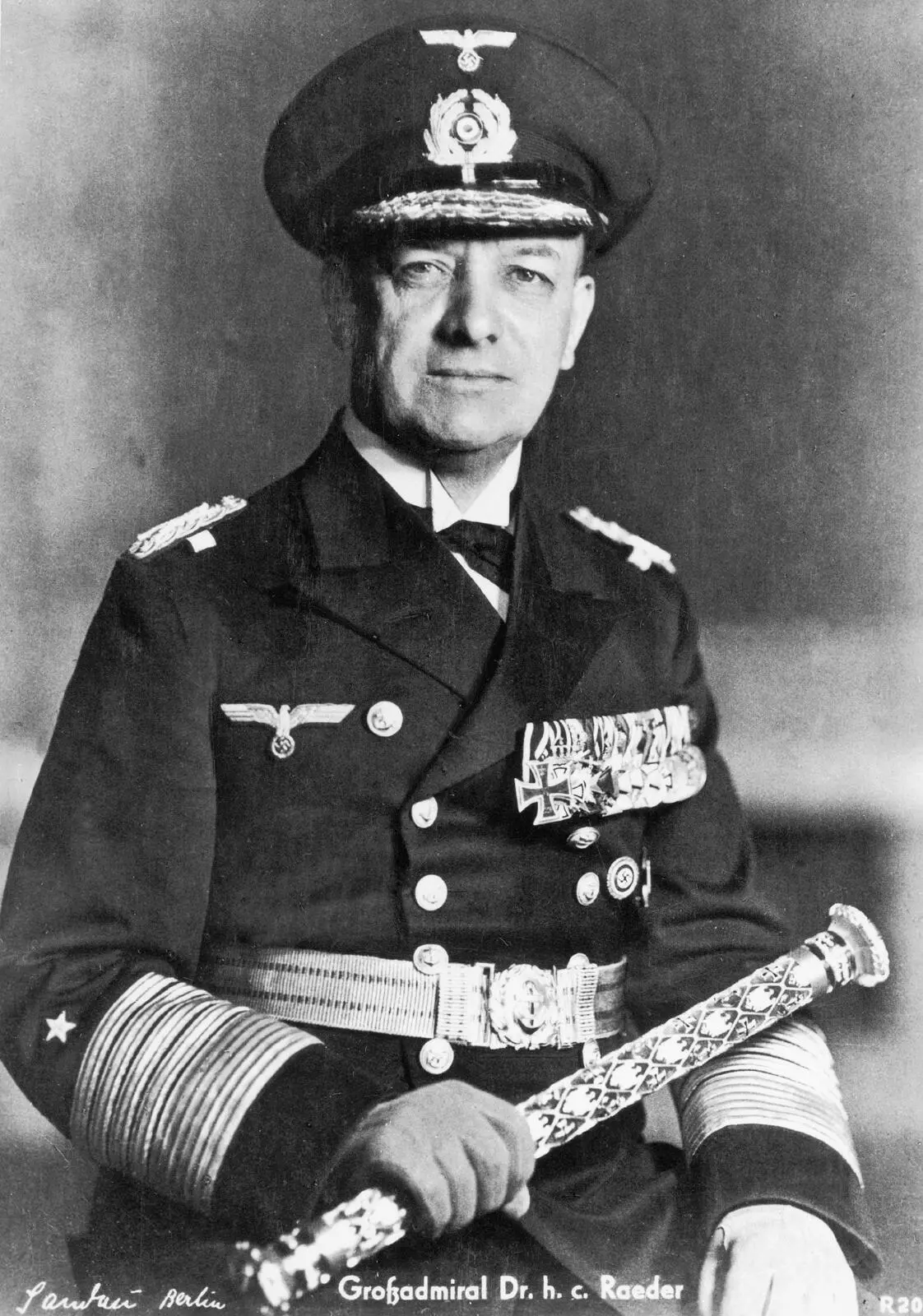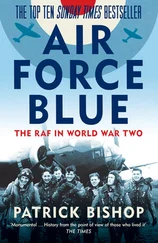The Führer and the admiral’s daughter stood in the blustery wind for a minute or so in uncomfortable silence. Eventually he looked down at the sea of joyful, upturned faces and, ‘in a sort of monotone’, murmured: ‘I have sent trains to all parts of Germany, of Austria, of Czechoslovakia. It is the best propaganda.’ An official called her forward to the microphone. In a clear voice she declared: ‘By order of the Führer and Supreme Commander of the Wehrmacht, I christen you with the name “Tirpitz”.’ The bottle swung and smashed. A large, hand-lettered sign reading TIRPITZ in Gothic script was lowered over the side. Then the hull began to move slowly, gathering speed as it went, stern-first down Slipway No. 2 hitting the basin in a maelstrom of churning water. Only the steel vanes welded onto the sides, sticking out like elephant’s ears, prevented a collision with the far jetty. The cheers of the crowd mingled with ‘Deutschland Über Alles’ blaring from loudspeakers as the notables descended the steps and were driven to the town hall square for the next event.
The day was charged with nervous expectation. The world was watching Wilhelmshaven. Europe was sliding towards war and Hitler’s words might give a sign of how fast or slow the catastrophe would be in coming. The omens were not good. The previous day Britain had abandoned its policy of appeasement. The decision had been forced by Hitler’s demand that Poland hand over the free city of Danzig, prised from Germany by the Treaty of Versailles. The Prime Minister, Neville Chamberlain, who stood by timidly as the Reich swallowed Austria and Czechoslovakia, had at last made a stand, telling the House of Commons that Britain and France would lend Poland ‘all the support in their power’ if Germany attacked.
The volte-face triggered a Wagnerian rage. Hitler had hoped he would not have to go to war against the British. Admiral Canaris, the head of German Military Intelligence who was with him when the news came through, watched as he pounded his fists on a marble table, his face contorted with anger, shouting that he would ‘cook them a stew they’ll choke on’. 2At around noon, Hitler began the speech everyone was waiting for. Wilhelmshaven’s main square had been decked out Nuremberg-style with flags and banners. Reporters in the press area noticed something they had not seen before at such events. Hitler was standing behind a curved glass screen, apparently designed to protect him from an assassin’s bullet.
His speech was long and disjointed, now soft, now hard, swinging between cajolery and bluster. Its main theme, though, was Britain, or ‘England’ as Germans chose to call it. The change of heart in London amounted to a declaration of enmity. Instead of staying on the sidelines as Hitler had hoped, Britain, its army and above all its navy would now have to be counted in the forces arrayed against his plans for European domination.
He started by reopening an old wound. He reminded the crowd that during the last war the British had ‘systematically’ encircled Germany, imposing a ‘hunger blockade’ that had resulted in hundreds of thousands of deaths. Now, by blocking her efforts to reclaim her historic territories, she was seeking to do so again. Germany, he warned, was ‘not going to put up in the long run with a policy of intimidation or … of encirclement’.
The warning was reinforced by a threat aimed at the British navy – which had enforced the wartime blockade. Only four years before, Britain and Germany had agreed a naval pact that limited the size of the German fleet. It had been based, he said, ‘on the fervent desire we all possess never to go to war with England’. He went on: ‘If this wish no longer exists in England, then the practical condition for this agreement is removed.’ The German people would be ‘quite content to put up with this. We are so sure of ourselves because we are so strong and we are strong because we are united.’ 3
The speech ended in a volley of ‘sieg heils’. Hitler was driven away to board a launch which sped out into the sparkling waters of Jade Bay, carrying him to the battle cruiser Scharnhorst, which had gone into service less than three months before and seemed to embody all the power and vigour of the new order. There he was met by Erich Räder, carrying the baton which marked his promotion that day to the rank of Grossadmiral – the highest pinnacle of the naval hierarchy.
At 2.30 p.m. they sat down to eat flanked by admirals and generals, past and present. The exaltation that flooded through Hitler during great public performances had subsided and he appeared subdued. ‘He arrived, saluted, sat down, spoke to his neighbours and disappeared as he had arrived,’ wrote Ulrich von Hassell *in his diary. ‘He said not a word to any of the old officers, nor did he even look them in the eye.’ 4

Erich Räder with grossadmiral’s baton
After lunch Hitler was ferried to another ship, the Robert Ley, a large liner that took party loyalists on holiday cruises. He stayed on board throughout Sunday, while the ship tacked back and forth in the waters off Wilhelmshaven, escorted by Scharnhorst and a pair of destroyers. To amuse the Führer, Räder at one point ordered the battle cruiser to steer directly at the liner, only swerving away at the last minute. 5
These carefree activities seemed calculated to demonstrate Hitler’s lack of concern at the new international developments. Whether he understood their full import for the navy he was reviewing was open to question. Naval matters played a subordinate role in Hitler’s military calculations, an attitude he did not bother to disguise. He was a soldier not a sailor. Throughout the time at Wilhelmshaven he had worn a brown greatcoat and tunic, the colour of the Flanders mud he had fought in bravely which stood out against the navy blue and gold braid of the attendant admirals. He came from landlocked Austria and was often seasick on his occasional voyages aboard the state yacht Grille.
Grossadmiral Räder, though, was disturbed by the turn that events had taken. He had been born sixty-three years before in Hamburg, the son of a devoutly Christian teacher, and entered the Naval College at Kiel at eighteen. It was the Dreadnought era when great battleships, bristling with guns and laden with armour plating, were the peak of naval power and prestige. He fought the British at Dogger Bank and Jutland and stayed on in the navy, serving the Weimar Republic loyally. In 1928 he was appointed Commander-in-Chief of the Kriegsmarine.
Räder kept his distance from Hitler until he came to power. His first impression of him was favourable. Hitler seemed to him ‘an outstanding personality with a real claim to leadership’. 6He had gained the Führer’s confidence and, once the strategic decisions had been taken, been given a free hand and a generous budget to build up the navy. Hitler had been presented with two choices for his navy. The first proposed a cheap, light, flexible force, centred on submarines and the small but powerfully armed long-range cruisers that the British had nicknamed ‘pocket battleships’. This plan had no pretensions to challenging Britain as a naval power but carried great potential to harm her. The second was to build a big fleet of modern surface ships that would establish Germany as a world maritime force. He had chosen the grandiose option, with Räder’s approval. The result was ‘Plan-Z’, which had been finally agreed by Hitler only two months before. It envisaged a fleet with ten battleships at its core and four aircraft carriers to provide the air power that was becoming a vital adjunct of naval operations. Supporting them would be fifteen pocket battleships, over a hundred cruisers and destroyers and an underwater strength of more than 250 U-boats.
Читать дальше













